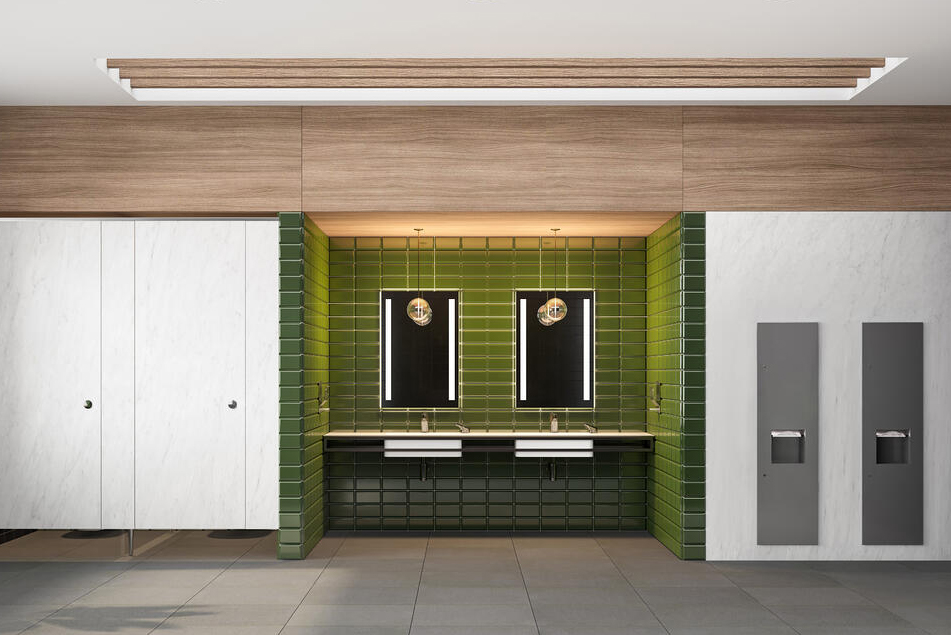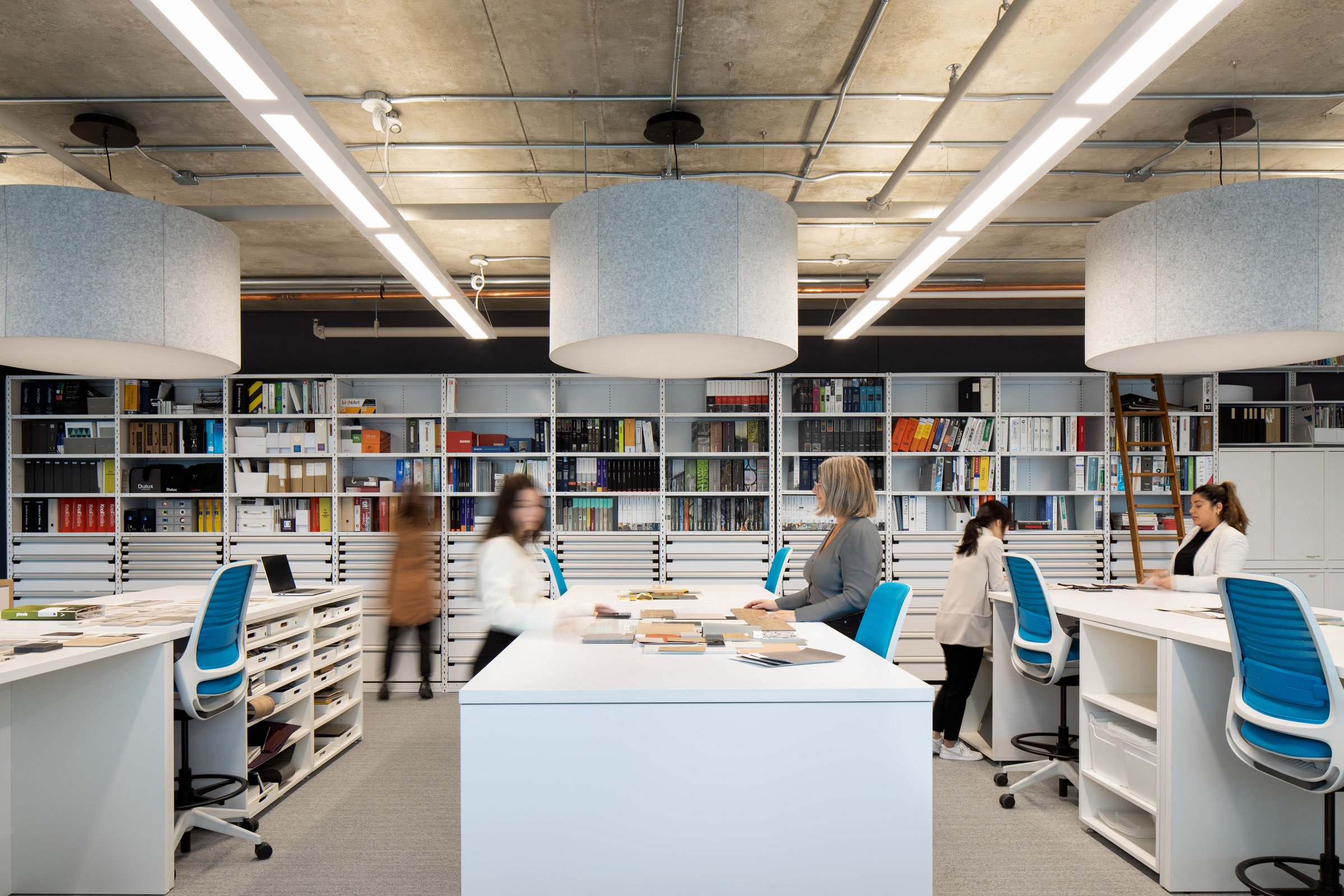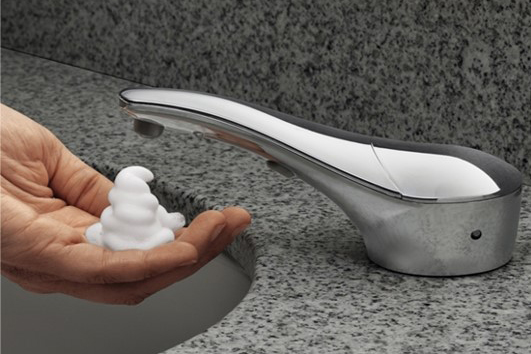The COVID-19 pandemic has changed design expectations for commercial and public restrooms. As buildings reopen and design professionals think about new projects, a restroom’s ability to support hygiene, health, and wellness has become a top consideration. Here’s how to design a restroom that puts occupants’ safety first.
How Do Architects and Facilities View the Hygiene Challenge?
According to new research conducted by Bobrick, hygiene is of the utmost importance to both architects and facilities professionals. A March 2021 survey of more than 300 architects and facilities professionals revealed that restrooms are the only area of buildings that ranked as a top-two area of concern for both groups. Further, 70% of architects and 92% of facilities professionals say hygiene is “extremely important” to their clientele.
Yet the research also revealed that architects and facilities professionals rarely consult with each other on projects. Only 15% of architects name facilities professionals as their top hygiene resource, while 6% of facilities professionals rely on architects most.
Meanwhile, new health and safety standards and accreditations have emerged, including WELL Certified and GBAC (Global Biorisk Advisory Council) STAR.
Although LEED is primarily seen as an environmentally focused certification standard, it does offer incentives for supporting patron health and wellness. LEED Green Cleaning Guidance for Safety First offers pilot credits for healthy cleaning practices to reduce virus spread, supporting physical distancing, ensuring adequate air and water quality, and more.
As new health and wellness standards emerge—and architects and facilities professionals explore ways to solve these new challenges—design and ease of maintenance become more important in the restroom. Compliance with ADA and ICC A117.1 accessibility standards remains a non-negotiable.
What Risks Do Restrooms Pose?
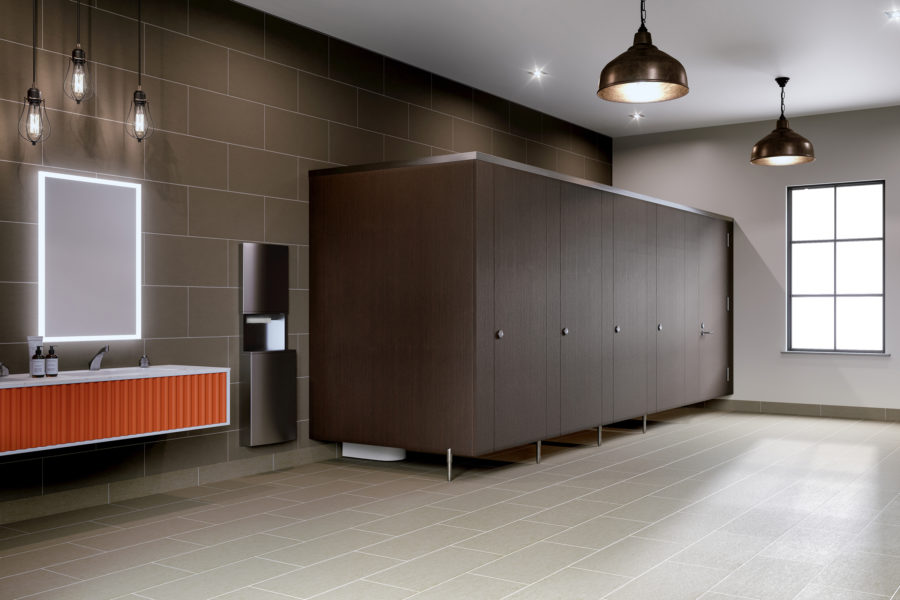
To provide a larger physical barrier between patrons, use increased-height toilet compartments and urinal screens. Image courtesy of Bobrick Washroom Equipment, Inc.
In a COVID-conscious world, the restroom poses a number of challenges. Respiratory droplets can be easily spread within 3 to 5 feet. Transmission can occur from person-to-person or via surface contamination. Poor air circulation can exacerbate potential risks.
Meanwhile, restrooms can be crowded, enclosed spaces, with numerous touchpoints and many shared surfaces—that is, surfaces that multiple people may touch with their hands throughout the day. A single restroom utilizing manual accessories exclusively can present 15 or more potential touchpoints to a single user. Keep in mind these multiple touchpoints have to be cleaned every day as well.
For today’s restrooms, reducing touchpoints while supporting the Centers for Disease Control & Prevention (CDC) guidance for handwashing, occupancy and disinfection are overriding objectives. In fact, Bobrick research indicates that both architects and facilities see “touchpoint reduction” as a top concern in restrooms.
Which Places are Most at Risk?
While all restrooms moving forward will require modified design approaches, knowing which building types are at highest risk can help prioritize solutions.
Restaurants, malls and gyms re identified as places with the greatest risk for transmission. A facility being indoors or outdoors, as well as crowd density and patrons’ ability to keep a mask on throughout their visit, are significant factors in determining whether a building carries a high or low risk of transmission.
What Does the CDC Say?
The CDC guidance on returning to the workplace environment advises that one of the most effective ways to stop the spread of infection is with frequent, proper hand hygiene—specifically handwashing and drying. Restrooms must be safe spaces where someone can clean their hands and feel good about the process.
The CDC also suggests when returning to the workspace, the traffic flow and occupancy of spaces needs to be considered. Overcrowding of these spaces leads to easier disease transmission. A key point to consider is the condition and design of the airflow to these spaces. Are there adequate air exchanges and outside ventilation?
You also want to consider using signage and other signaling tactics to encourage users to adhere to CDC guidelines and recommendations.
The CDC also addresses the cleaning and disinfection of spaces. The CDC has a list of EPA-approved disinfectants for COVID-19 and suggests increasing the frequency at which surfaces are cleaned, when possible. From a design standpoint, it is critical to consider the types of surfaces used for moisture control, their ease of cleaning and their ability to stand up to the repeated exposure to disinfectants or just general longevity. Viruses and bacteria like to live in any small crack or space they can find. Nonporous, grout-less countertop surfaces are recommended for ease of cleaning and effective infection prevention.
Should I Specify Touchless Restroom Accessories?
- Both architects and facilities see “touchpoint reduction” as a top concern in restrooms, according to Bobrick research. Photo courtesy of Bobrick Washroom Equipment, Inc.
Prioritizing touchless products is one of the most impactful design strategies for post-COVID-19 restrooms. Touchless, automatic soap dispensers and hand drying solutions are now preferred by most facilities for their ability to reduce touchpoints and the peace of mind they offer patrons. In addition to touchless soap dispensers, touchless hand sanitizer dispensers, paper towel dispensers, and hand dryers also can support hygienic handwashing and hand drying and provide peace of mind.
Doorless entries and exits, as well as new technologies, such as anti-viral touch keys, also are emerging as popular solutions. You should also prioritize touchless plumbing fixtures, such as faucets, toilets and urinals, over manually operated products.
Some toilet compartment door latches can operate without grasping the latch with fingers. This hardware allows users to both secure and unlock the door with a quick flick of the wrist, forearm or elbow. The hands-free L-shaped latch/handle can be used on newly designed toilet compartments or retrofitted on existing compartments to reduce contact with shared surfaces.
- Some toilet compartment door latches can operate without grasping the latch with fingers. Photo courtesy of Bobrick Washroom Equipment, Inc.
How Should I Re-Evaluate Product Placement?
The COVID-19 pandemic has prompted many facilities to reconsider where amenities are placed.
As facilities must now spend more time sanitizing and disinfecting all parts of the building as required by many health and wellness standards, it becomes even more important to minimize cleanup and maintenance wherever possible. Thoughtful placement of accessories can help ease the burden.
To help minimize potentially unsanitary water and soap trails on the counter, it is important to use counter-mounted soap dispensers. If you’re specifying a paper towel dispenser or combination towel-waste unit, it should be placed as close as possible to the lavatory to minimize water trails on floors.
Touchless or foot-operated floor-standing waste receptacles can be placed between lavatory stations to increase waste capacity.
To further support user peace of mind, you should also consider providing additional amenities inside toilet compartments. To address shared surfaces, such as grab bars and toilet compartment door handles, toilet compartment interiors can include a hand sanitizer dispenser, paper towel dispenser, and a waste disposal to ensure optimal hand hygiene while inside and exiting the compartment.
Personal device holders are also available to help keep personal belongings off potentially wet or unsanitary floors. These can be installed at the lavatory and even inside toilet compartments to keep personal items off wet countertops and floors.
What About Physical Distancing?
While it is unclear how much longer the CDC’s 6-foot distancing recommendation will continue—the CDC has recently updated its operational strategy for schools to include a 3-foot distancing requirement—the COVID-19 pandemic has prompted users to redefine their comfort zones when it comes to personal space. During the pandemic, signage emerged as an essential solution for encouraging users not only to wash their hands properly but also to maintain appropriate distance from other users.
Moving forward, various occupancy signaling solutions are available to inform patrons when compartments are occupied and make them more comfortable. To provide a larger physical barrier between patrons, increased-height toilet compartments and urinal screens (at least 84 inches tall with 3 inches or less of floor clearance) can be used.
At the lavatory, screens up to 84 inches tall can be specified at the countertop to provide barriers between handwashing stations. For the countertop material and throughout the restroom, nonporous, grout-less surfaces should be specified for easy cleaning and disinfecting by maintenance staff.
To assist with air circulation, HVAC systems can be programmed to flush air two hours before and after occupancies per ASHRAE standards. Advance maintenance should be performed to maintain quality air filtration, and relative humidity of 40% to 60% should be maintained, per UL standards.
Are Restroom Layouts Being Re-evaluated?
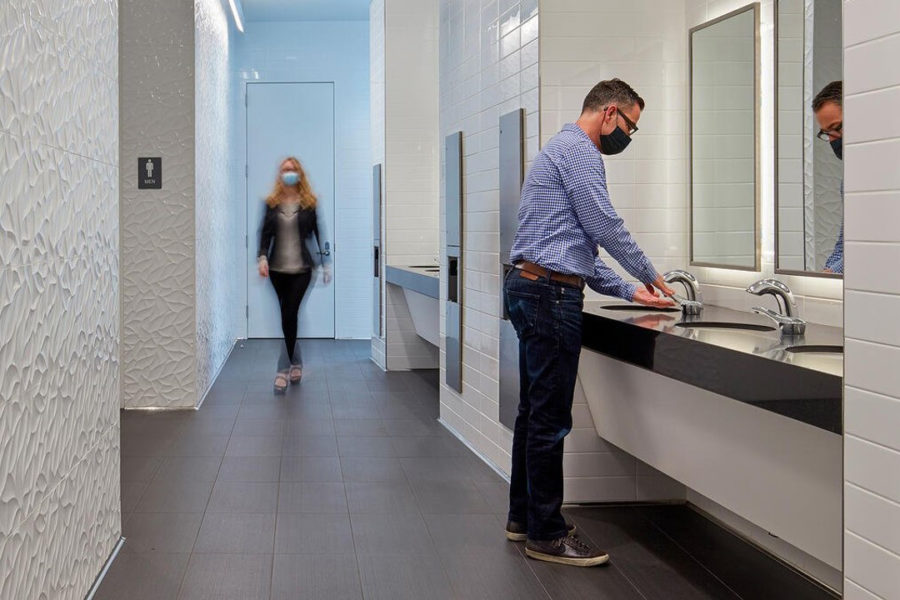
Shared, nongendered handwashing stations are emerging as a solution that uses social pressure to incentivize handwashing. Photo courtesy of Bobrick Washroom Equipment, Inc.
Today’s design professionals are reconsidering many established restroom density and design assumptions to address health and wellness needs, from the locations of handwashing stations to traffic patterns and more.
Although facilities can take relatively simple steps to adjust space utilization and reduce restroom capacity—such as blocking off alternative lavatories, toilet compartments, and urinals—designers working on new projects should re-evaluate restroom layouts on a holistic level. For example, shared, nongendered handwashing stations are emerging as a space-effective solution that uses social pressure to incentivize handwashing in public view. Restrooms can be designed with two-sided entries and exits to facilitate distancing and assist with traffic flow. Doors can be removed from entries and exits, as well.
How Can I Support Facility Professionals?
Bobrick research suggests that architects and facilities professionals don’t often consult with each other on new construction and renovations. Through thoughtful product selection, design professionals can help support effective cleaning and sanitation.
Specifying nonporous, easily cleanable surfaces can help. In addition, it should be easy to obtain refills for soap dispensing products—and to refill them. Proprietary soap systems require the facility to use smaller, individual plastic soap cartridges. These proprietary soap cartridges may pose supply chain interruption risks. If a facility’s soap dispensers do not have the correct cartridge, the dispensers will not operate safely and reliably.
On the other hand, when you specify a nonproprietary or “bulk” soap system that uses open market soap, facilities stand a much better chance of keeping their dispensers and stock rooms full through reliable supply chain availability. Plus, they can be top-filled and produce less waste. This is an example of a facility maintenance challenge that architects can work through with their clients.
A 360-Degree Perspective
In designing restrooms for a post-COVID-19 world, restrooms should be evaluated from the perspectives of all restroom stakeholders, from users to facility operators to building owners. This will help architects, facilities and their clients build more effective working relationships that result in cleaner, safer restrooms.
An overall risk assessment should be conducted to address physical distancing, density, air quality, and more. Thoughtful product selection should meet patrons’ hygiene needs while ensuring smooth, reliable operation. Space and layout should optimize physical distancing with traffic flow, queuing and accessibility. From a cleaning and maintenance perspective, products should be easy to clean and refill to help mitigate risks.
When all perspectives are considered, the result is a clean, healthy restroom where everyone can feel safe.

